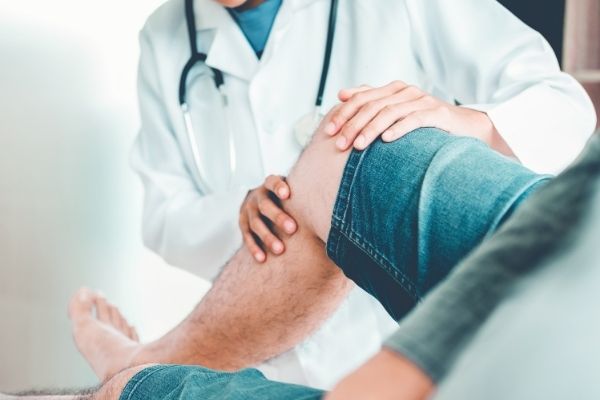As the hype of a New Year fizzles, so does the commitment to New Year’s resolutions! Resolutions like exercising more, eating healthily, losing weight, taking a more active approach to health, etc. The sad fact is that only 8% of individuals that make New Year’s resolutions, actually stick to them! Although these New Year ‘s goals seem mentally attainable, there may be physical limitations due to chronic pain making them unachievable. One of the most common ailments that is physically debilitating is Sacroiliac or SI Joint pain.
Sacroiliac or SI joints are responsible for carrying the weight of the entire upper body and extremities! There is an SI joint on either side of the lumbar spine which connects the spine to the hips and pelvis. These incredibly durable joints are surrounded by cartilage and ligaments that serve as shock absorbers amongst these areas making them susceptible to damage and inflammation. Thus, generating pain and making it difficult to complete particular exercise routines. Some of the most common complaints during physical activity due to issues with the SI joints are:
- Irritation while walking/running for a long period of time
- Low back or pelvic pain when bending/twisting and lifting heavy weights
- Aggravation when climbing
- Low back, pelvic, and leg pain when riding a bicycle
- Low back and pelvic pain when doing sit ups/crunches
- Irritation during squats/lunges
If you experience any of the listed complaints of SI joint pain during exercise, or even normal activity, don’t give up on your New Year’s resolution goals! There are ways to commit to a healthier lifestyle when improvised routines have been established. For instance, try walking or running in moderation, lift lighter weights and avoid lifting heavy objects, avoid squatting or lunging, and climbing. Also, incorporate stretching! Try the examples below to soothe and prevent SI joint pain!
- Double Knee Hug
- Lie down on your back with your legs out long
- Lift both of your knees to your chest
- Hug your knees to your chest with your arms and hold for 30 seconds.
- Lower Trunk Rotation
- Lie on your back with your knees bent and your feet hips-width distance on the floor.
- Bend your forearms upward until your elbows are level with your shoulders
- With bent knees, twist your torso and allow your bent knees to fall towards the right slowly. Slowly lift your bent knees, twist your torso, and allow your bent knees to fall towards the left.
- Bridges
- Lie on your back with your knees bent and your feet hips-width distance on the floor. Reach your arms down by your sides with your palms facing down.
- Engage your abs and inhale to lift your hips up towards the ceiling to come into a bridge.
- Engage your glutes and inner thighs. Hold for 30 seconds, then slowly release one vertebra at a time.
If the suggested stretches and revised routines don’t help alleviate SI joint pain, be sure to reach out to our office! Our physicians tend to suggest a series of tests to confirm SI joint dysfunction. According to our Nurse Practitioner, Heather, “tests like thigh thrusts, SI joint compression, and Faber tests can be done during a consultation to confirm that the SI joint is the source of pain.”
- Thigh Thrust Test– the provider will have the patient lie on their back, the hip should be flexed at a 90-degree angle with bent knees. The physician will then apply pressure along the length of the femur, or thigh, and one hand is placed beneath the hips while the other hand is used to apply a downward force to the thigh.
- SI joint Compression– the patient is lying on their side and the examiner’s hands are placed over the upper part of hip, pressing toward the floor. The movement causes forward pressure on the pelvic area.
- Faber Test– The patient is lying on their back. The leg is placed in a “figure-4 position”. While stabilizing the opposite side of the pelvis with one hand the other will manipulate the bent knee until maximum range of motion has been established.
After the series of SI joint tests have been completed, non-surgical options may be recommended to help alleviate SI joint pain and get you back on track to meeting your New Year’s goals! One option is SI Joint injections. During the procedure, a light sedation is administered, and the Sacroiliac Joint area is numbed with a local anesthetic. Once the patient is comfortable and the joint is numb, a needle is inserted into the SI joint using fluoroscopic or X-Ray, guidance. Once the needle is positioned, a contrast dye is injected into the joint area. The dye is injected to ensure that the needle is properly situated, and the medication is spread appropriately. Finally, a compounded medication is injected into the joint. After the procedure has been completed, the patient is able to return home. Most patients resume normal activity within days. Heather also states, “SI joint injections have an extremely high success rate with pain relief results lasting for months!”
Our patient, Mrs. Jackson, was eager to take an active approach to a healthier lifestyle so she proceeded with our SI Joint injection. She states, that she “dealt with so many pain specialists over the years, but Dr. Schuyler has consistently done the best job at hitting the pain target every time. That way we don’t have to go through the injection process over and over again with no relief. I can finally do my physical therapy!”
Let Southern Coast Pain Specialists help you manage your SI joint pain and create real change in your life! We want to help you commit and achieve your New Year’s Resolution goals. We hope you have had a wonderful start to your New Year and keep up the good work! Also, be sure to refer to past blogs for alternative ways of living pain-free!







